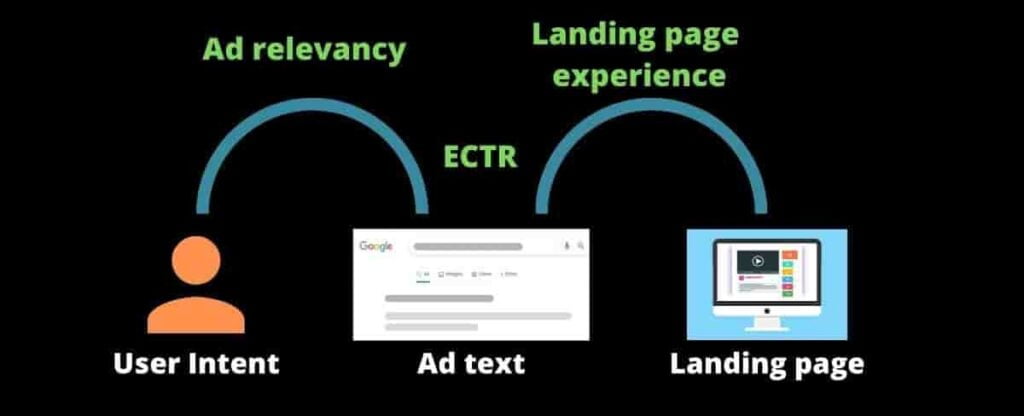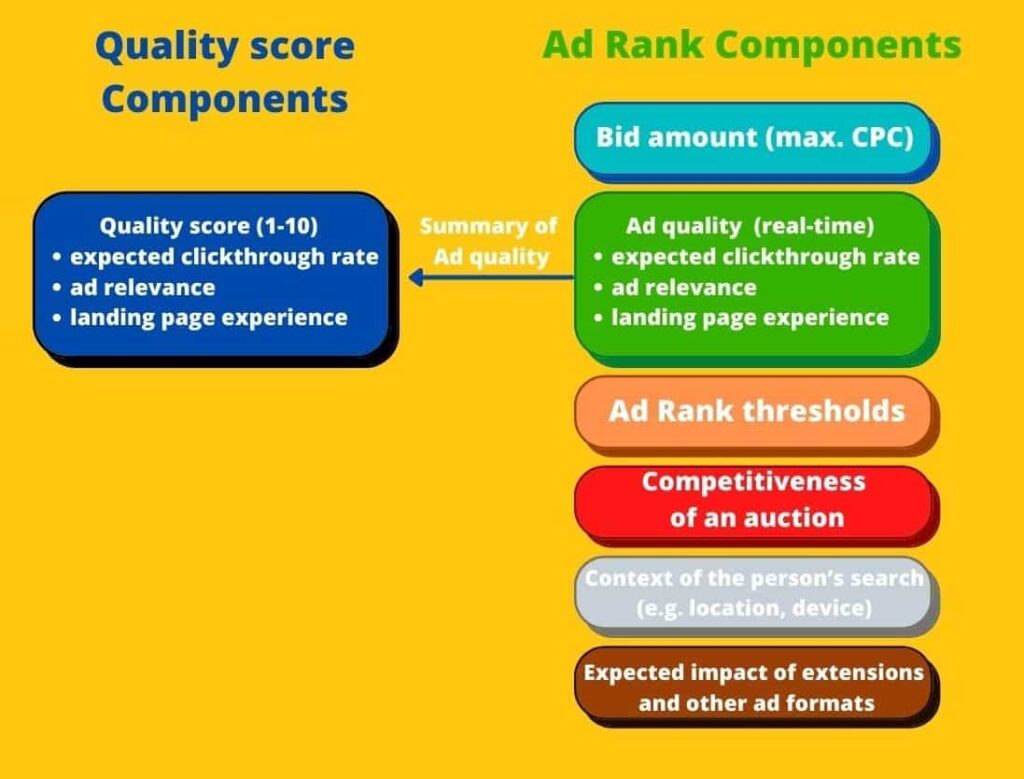What is a low Quality score? [With Examples]

Every advertiser tries to minimize his/her expenses as much as possible.
One of the ways to do that is getting a higher Quality score or at least not getting a lower score, which increases your expenses.
Today we are going to talk about the latter in more detail and find out what is a low Quality score, the reasons for that, and the ways of improving it.
Let’s get started.
A quick intro to Quality score (QS)
QS is an indicator that represents the overall quality of your ads on a scale from 1 to 10, with 1 being the poorest and 10 the best performer.
Overall, your ad quality is measured based on the following three interrelated components:
- Expected CTR (ECTR) – the likelihood of receiving ad clicks
- Ad Relevance – evaluates how well your ad matches with the intent of the searcher on the SERP
- Landing page experience – evaluates the experiences of users who visit your landing page

Why Quality score is an important metric?
Because it shows the summary of one of the most important factors in Ad Rank known as Ad quality. And you can only track this metric and your bid prices to get some idea about how your Ad Rank is calculated.
With the remaining factors of Ad Rank, you cannot have a clear picture of how they are performing.

Note: Quality score is not used in the real-time auctions. It is just a simplified indicator to get a general idea and it doesn’t cover a lot of factors that affect Ad Rank.
To learn more about Quality score, check out my other articles.
What is a Low Quality score?
Different industries can have different standards when it comes to defining low Quality score.
Generally accepted range to be considered as low is 1, 2, 3, 4 scores.
But, it is not a rule. Sometimes even if you get a score of 6 and you have a lot of competition, that might be considered low for your industry.
A low Quality score is like a red zone you don’t want to reach. The lower your score, the higher you pay in the auctions.
However, your price doesn’t only depend on the QS. As I said, there are many other factors involved in the calculation of Ad Rank
Note: Ad Quality and Quality score have the same components. But, while Quality score is for advertisers, Ad quality is used in the Ad Rank calculation and is only known by Google ads.
The best practice is you need to arrange the order of your keywords from the lowest to the highest Quality score and start improving your campaigns from there.
To get the fastest result, you need to start the improvement from the most underperforming metrics like picking the components with the lowest score (e.g. below average score).
For example, if you have a below average score for Landing page experience and an average score for Ad relevance, you don’t want to start improving your campaigns from Ad relevance. Because if you improve the Landing page experience first, your overall performance may grow more than you start with Ad relevance.
Can keywords with a low quality score participate in ad auctions?
A keyword can participate in the ad auction with a low Quality score if there is a low Ad Rank threshold for that particular keyword.
Ad Rank threshold depends on several factors like the nature of the keyword, the user attributes (e.g. device, location), etc.
So, the QS is not the only factor to meet the minimally required Ad Rank threshold and you need to consider other factors as well
Reasons for low Quality score
Now, it is time to discuss the root of the problem.
What are the reasons for a low quality score?
These can be the following:
1.The number of impressions can be too low
There is not an exact number of how many impressions or clicks an ad needs to generate its Quality score.
But, Google ads states that if you have impressions under 10 000, your Quality score may suffer.
This can be the reason for most of the new campaigns or campaigns with recent low traffic volume.
2. A component of QS may be underperforming
Factors that get you below average scores with ECTR, Ad relevance, and Landing page experience can drag down their combined performance, which is their Quality score.
For example, if your bounce rate is too high and your landing page isn’t related to your ad text and the searcher intent, your score with Landing page experience can decrease your QS considerably even if you have high scores with other components.
3.Your keywords are too broad
Broad or short-tail keywords are one or two word sentences that generate a lot of clicks. But, they reduce the scores of your Ad relevancy and Landing page experiences.
For example, if you specialize in advertising on Google ads, choosing the keyword “online advertising service” may also bring you users who are looking for “Pinterest advertising services” to your website.
To learn more about changing your Quality score, check out this.
How to fix a low Quality score?
These are some of the most common ways to fix your low Quality score.
Start the improvement from the 3 components of QS
First of all, start the improvements from the components of Quality score.
- To improve Expected click-through rate, write more compelling headlines that promise to solve your ideal customers’ problems
- To improve Ad relevancy, target keywords that match with the intent of the searcher on the SERP
- To improve Landing page experience, improve the ease of navigation, make the content of the landing page relevant to your ad text and improve overall user experience
Group your keywords
To increase the relevancy of your ads, group your keywords into tightly themed separate ad groups. Then, each ad group is served for a particular audience group.
Use negative keywords
Exclude some of the underperforming keywords by adding negative keywords.
Be more descriptive in your headlines
Being more descriptive increases your conversion rate because a user clicking your ad becomes more familiar with your business before clicking it.
Adding more characters to your headline may not increase your CTR but it can increase your Ad relevancy and Landing page experience.
Don’t use DKI (Dynamic keyword insertion)
Dynamic keyword insertion is great if you just want to increase your CTR.
However, it does more harm than good.
It increases your cost and may lower your Quality score because the relevancy of your ads drops significantly.
Increase the page load speed
Page speed may not be a direct factor in the Quality score calculation, but it impacts the user experience.
Is a low Quality score really bad?
A low Quality score may increase your costs. But, if you are making money with a low Quality score and you have done everything about creating relevant ads for your customers, you shouldn’t worry about it.
Many advertisers are so obsessed with this metric that they build all of their campaigns just to get a high Quality score without considering its negative consequences.
In general, a low Quality score is a bad sign for most advertisers and it means they are doing something wrong in their ad creation. However, it is just the indicator of Google ads and it doesn’t consider the conversion rate in the calculation of the QS which is the most important metric for your business.
Conclusion
Quality score is a good metric to gauge the quality of your ads.
Once you have identified the keywords with a low Quality score, try improving their Quality score components and other factors that decreased the performance of those components.
Surely, after that, you can see the improvements in your expenses as well.
As I said, sometimes you don’t have to change your best performing campaigns just because they have low Quality scores.
So, make use of this indicator wisely to boost your campaign performance.
Do you have any questions about this article?
If so, let me know in the comments section below…
For any help in your Google ads campaign management, you can contact me through the Contact page.

